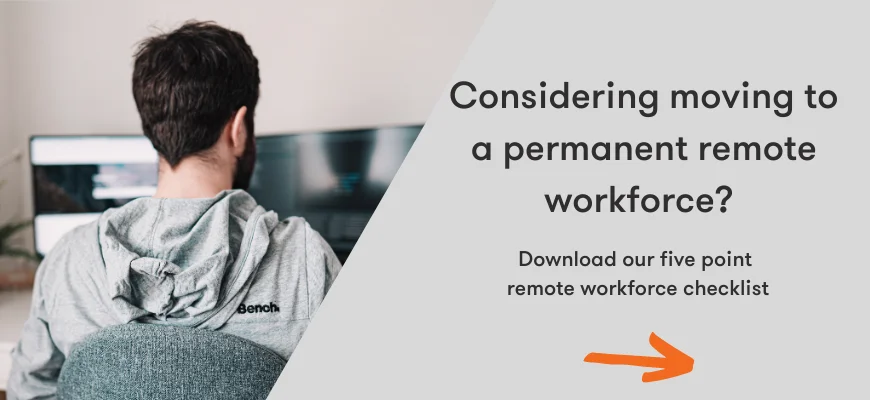Over the past few years, working remotely has become a key requirement for many organisations, but when Covid-19 hit and caused the UK to enter lockdown, then it became almost essential. Having switched to working remotely, many businesses may now be considering ditching the office all together. However, moving to a permanent remote workforce is not a simple undertaking, and whilst many organisations have the tools to do this, there are other, wider issues to be aware of.
In this blog we begin to address some of the considerations when moving to a permanent remote workforce, and help you understand the overall process of doing this successfully. Due to the fact we have moved numerous businesses to remote working set-ups, we have a pretty good idea of the sort of things it is important to think about before taking the leap.
Download our Remote Workforce five point checklist
Stage 1 - Analyse:
This stage is where you look at all the systems and processes within your organisation and gather as much information as you can. Useful questions to ask at this stage are:
- What does everyone do on a daily basis?
- How much of this can they do remotely at the moment?
- What tools do they need to do this fully remotely?
- How do we interact with the outside world in a non-digital way (for example, how do we handle the post now? What about meetings, or phone calls?)
- How do we support and effectively manage our team?
- How do we ensure that our team remain productive?
- Which of our IT systems work remotely at the moment, do they work well? Do we need to increase the bandwidth or reconfigure any of the systems?
- Can we access our data remotely and securely (if it is on a server, are we using an SSL (secure) VPN?)
- What equipment do we need to provide? Do we need to provide a phone that works from home? Do we need to provide a laptop, and possibly an extra screen to make life easier for our staff?
- How do we cover the health and safety of our team?
- Do we want to meet up as groups or a whole team at all? If so, where would we do this?
Stage 2 - Plan:
At this stage you plan how you will all work in a remote environment, at this stage you will:
- Decide on which systems you will need to change or digitise further. Start with the core business applications that you use, and plan to make sure that they work well remotely. Anything that relies on paper will need to be thought through, but there are many solutions out there to allow you to fully digitise (for example a new CRM) – make use of this opportunity.
- Decide on how you want to work remotely
- Decide on how you will support, manage and ensure that your team are productive
- Decide on changes to HR, health and safety, management and meetings
- Decide when these changes will happen, and who will action them
Stage 3 - Implement:
This is where you implement all of your plans and move to a new way of working, and will typically involve:
- Investing in new systems or equipment to work fully remotely, which will likely include some hardware (Laptops / Phones / Screens and better broadband), as well as most likely moving away from your server and making the most use of modern cloud-based systems to allow efficient remote working
- Training staff on how to use these systems
- Setting new expectations for working fully remotely – including any new expectations of how people are to communicate, collaborate and work
- Support people as they get used to a new way of working, and managers with a new way of managing
Stage 4 - Engage:
This is the last stage, but you will find that this is something which you need to continuously do. In the same way as you would look to engage your team when they were in the office, you will need to ensure that you put as much effort into this continual engagement.



